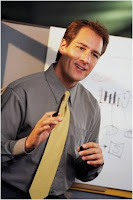 Writing is one-way communication. But presentations should never be. With your audience in the room, why would you talk at them rather than converse with them?
Writing is one-way communication. But presentations should never be. With your audience in the room, why would you talk at them rather than converse with them?- You think you have to. You were asked to make a "presentation." Doesn't that mean you talk, they listen? Not necessarily (see below).
- Habit. Like most of us, you didn't even consider the alternative of taking a different approach than what you normally do. It's much easier to follow the rote process.
- You're focused on what you have to say rather than how it will be received. That's the fundamental flaw with most presentations. They're speaker-driven rather than audience-driven.
- You tend to perform rather than connect. That's the way presentation skills are often taught. It becomes acting rather than interacting.
- Oh, and the PowerPoint thing. People seem to love to hate PowerPoint. But it's not the software's fault. It's a great tool! The problem is how people use it.
There's ample evidence that communication vastly improves when people engage, when there's a conversation. The other party is more attentive, there is better comprehension and retention, and persuasion is significantly enhanced. So when there's a lot resting on your presentation, it's best to present less and engage more. How? A few suggestions:
Ask questions. This is the quickest way to break form with the traditional one-way presentation. Plan to include questions at critical junctures in your talk. Use questions that help illustrate your point or provoke thought on a particular issue. Questions can also help you better understand where your audience is coming from. That way you can more specifically tailor your presentation to your audience.
I have used questions in shortlist presentations for many years with great success. In the typical scenario, the client asks for a 20- to 30-minute presentation followed by questions and answers. Most A/E firms mindlessly oblige, forcing their team members into a role that few excel at--formal presentations. When clients are looking for chemistry and comfort, that hardly seems the right formula.
So I coach teams to request permission to ask the client a few questions in the course of their presentation (that request has only been denied once in 18 years). We insert a question or two at key transitions in the presentation. That encourages a more informal dialogue that engages the client, clarifies what the client is looking for, and puts our team more at ease. This approach better enables the formation of chemistry and comfort.
Have the audience do something. People learn more and are more persuaded by doing than by listening. So audience involvement is recommended. There are a number of ways to do this. Have them perform a little exercise or self-assessment, talk to the person beside them about a particular topic, or simply raise their hands in response to a poll question. Be creative. This is also a good approach with large audiences where inviting dialogue is more difficult.
Plan on no more than one slide every four minutes. This is a rule of thumb a veteran trainer shared with me years ago and it works! Whenever I try to cheat the rule by adding a few more slides ("Oh, this slide will only take 10 seconds."), I get in trouble with time. So how does this increase engagement? If you're spending less than four minutes per slide, you're not engaging enough. Then see points #1 and #2 above.
Put PowerPoint aside occasionally. While effective slides can be powerful visual aids, they can also tend to isolate you from the audience. Your slides should never be the focus of your presentation; the audience is. Turning off the PowerPoint occasionally, and perhaps using a flipchart or white board instead, can help return your attention to where it belongs and promote better dialogue.
I once traveled five hours to do project management training, then discovered when I arrived that I had left my briefcase by the door at home. No laptop, no PowerPoint, no notes. Fortunately, I had emailed a handout to the client in advance, and I always carry my easel and flipchart in the trunk of my car. So that's what I used. There was great interaction and energy, and several commented (being familiar with me as a trainer) that it was the best session I had ever done.
So did I permanently ditch the PowerPoint? No, and I still tend to over-rely on it at times. But it reinforced an important truth: The more we converse, the better we communicate. Keep that in mind the next time you're asked to make an important presentation. Present less, engage more.

No comments:
Post a Comment